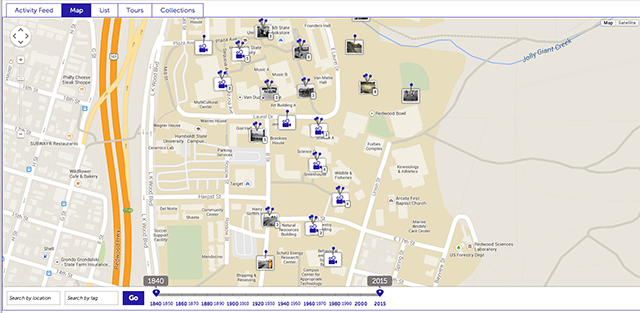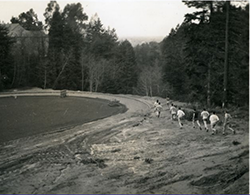Thanks to a new project by Humboldt State Library student-intern Grace Rotwein, anyone interested in local history can get a quick-and-easy online view of the school and town of Arcata, then and now. Rotwein’s Humboldt State Historypin project, completed during the fall semester, provides an HSU presence on social media platform Historypin, which allows users to pin historical content to Google Maps.

“HistoryPin appealed to me for many reasons, the foremost being that it is a highly accessible, easily navigable way to share and explore history,” said Rotwein, a history major who will graduate this spring. “Involving and educating the general public about local history is something that I believe is very important.”
And besides, it’s fun. For instance, clicking on the Google street view tab allows users to fade in and out of the historic image and the current scene. One photo illustrates the Arcata Plaza as seen in 1913 and now. Another shows the Founders Hall parking lot, circa 1949, located at the bottom of the steps.

After signing up for an account, visitors can also add their own photos–past and present–and pin video and audio. All components are visible to the public in digitized collections of HSU and local area content.
A true historian, Rotwein poured through campus archives to find suitable illustrations, labeling, dating, and adding descriptions to each piece. Taking the user-friendly system one step further, she organized the elements into collections and tours of campus, complete with mobile access.
Supporting and directing Rotwein’s efforts was Carly Marino, a reference librarian in the Special Collections Humboldt Room. Marino brought the idea back from a presentation she had viewed at a Society of American Archivists conference. When Rotwein began her internship, she was enthusiastic about tackling the project.
“Grace has been an innovator with this project, taking the time to curate the photos and provide details,” Marino said. “Online exhibits like this have the ability to give lesser-known collections a new life.”
Rotwein and Marino agree that the PinIt project holds other possibilities, including marketing and academic applications.
“HistoryPin could be used to showcase Humboldt history during walking tours with prospective students,” Rotwein said. “It could also be used in the classroom. It’s a highly accessible, easily navigable, way to share and explore history.”